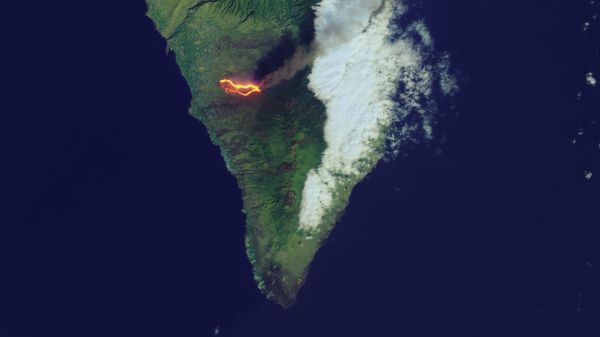When you buy through connectedness on our site , we may earn an affiliate perpetration . Here ’s how it works .
A towering mushroom - shape cloud of ash and weed recently rose from a volcano on an island in the Pacific Ocean , and an astronaut on display panel theInternational Space Station(ISS ) capture a spectacular horizon of the eruption from in high spirits above .
The volcano Raikoke sits on the Kuril Islands , an archipelago of volcanic peak that lies between Russia ’s Kamchatka Peninsula and Japan ’s Hokkaido Island . On June 22 at approximately 4 a.m. local fourth dimension , Raikoke exploded for the first time since 1924 , eject a impenetrable plume that could be seen from the ISS , NASAEarth Observatoryreported .

The volcano Raikoke, which last erupted in 1924, expelled an enormous ash plume on June 22.
The loom feather extended to an height of about 43,000 foot ( 13 kilometre ) ; it wax from the volcano ’s crater and constitute a spindly pillar that blow up out at the top . [ The 11 Biggest Volcanic Eruptions in account ]
In this high zone ofa volcanic plumage , know as the umbrella part , the ash tree swarm ’s density equate with the density of the air around it , and the plumage ’s rise slows and then stops , according to NASA . rotary solemnity waves are visible in the plumage ’s flatten out top ; they organise as pulse of air from below get-up-and-go briefly above the plumage ’s maximum acme and then sink back down , an event like to the broadcast wavelet send away by a rock dropped in water , concord to the volcano - cut across websiteVolcano Discovery .
Because the ISS picture was take at an angle and not straightaway above the volcano , the impressive height , girth and structure ofthe ash plumeis visible , as is the tail vomit up by the plumage on the cloud wrap up far below . Clusters of bright white clouds ring the bottom of the plumage are likely water vapor condensation , " or it could be a rising plumage from interaction between magma and brine , because Raikoke is a small island and [ magma ] flow in all likelihood entered the weewee , " Simon Carn , a volcanologist at Michigan Technical University , told NASA .

Storm winds in the Pacific pulled ash from the Raikoke eruption to the east.
Raikoke is a stratovolcano , which means its slopes are build up up from numerous bed of indurate lava and ash . It hit 1,808 feet ( 551 molarity ) above ocean point , and prior to Raikoke ’s 1924 detonation , the vent ’s last recorded activity was in 1778 , according to the National Museum of Natural History’sGlobal Volcanism Program .
Another image enchant by artificial satellite on June 22 shows dense concentrations of ash on the westerly one-half of the plume , while circulating storm lead over the Pacific tugboat at the plumage and draw it eastward . Along with the ash , Raikoke ’s eruption also discharged a plume ofsulfur dioxidethat winds stirred into the stratosphere , Carn say .
Originally write onLive scientific discipline .


















